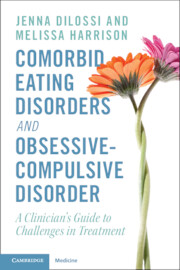 Comorbid Eating Disorders and Obsessive-Compulsive Disorder
Comorbid Eating Disorders and Obsessive-Compulsive Disorder from Part II - Clinical Pitfalls and Treatment Failures
Published online by Cambridge University Press: 14 December 2023
The primary empirically supported treatments for EDs are CBT-E and FBT. Both recommend a limited treatment team that includes a primary therapist who focuses on changing eating behaviors, weight, and related body image concerns; a medical provider to monitor stability; and a psychiatrist for medication management of any comorbid diagnoses. Dietitians may be used as consultants, and other types of therapy should be suspended during treatment. This approach aims to reduce the risk of conflicting messages among providers, treatment fatigue, and reinforcing of safety behaviors, but it has not yet become standard practice in ED treatment (particularly in the United States). Despite evidence supporting the efficacy of CBT-E and FBT, outdated ideas about ED maintenance and treatment persist in the healthcare community, which can be a challenge in treatment, especially when the patient also has a co-occurring diagnosis of OCD.
To save this book to your Kindle, first ensure [email protected] is added to your Approved Personal Document E-mail List under your Personal Document Settings on the Manage Your Content and Devices page of your Amazon account. Then enter the ‘name’ part of your Kindle email address below. Find out more about saving to your Kindle.
Note you can select to save to either the @free.kindle.com or @kindle.com variations. ‘@free.kindle.com’ emails are free but can only be saved to your device when it is connected to wi-fi. ‘@kindle.com’ emails can be delivered even when you are not connected to wi-fi, but note that service fees apply.
Find out more about the Kindle Personal Document Service.
To save content items to your account, please confirm that you agree to abide by our usage policies. If this is the first time you use this feature, you will be asked to authorise Cambridge Core to connect with your account. Find out more about saving content to Dropbox.
To save content items to your account, please confirm that you agree to abide by our usage policies. If this is the first time you use this feature, you will be asked to authorise Cambridge Core to connect with your account. Find out more about saving content to Google Drive.